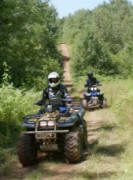 |
DEPARTMENT RESULTS |
|
|
| |
|
Goal:
Minnesota’s natural lands and habitats will be conserved and enhanced
|
|
Why is this goal important?
Minnesotans enjoy a rich and varied landscape. An impressive array of
natural resources and environments contributes to our high quality of life.
Natural lands support a diversity of species (see Fish and Wildlife goal),
abundant aquatic ecosystems (see Waters goal), and varied forests (see
Forest goal) that are a foundation for agriculture, timber production,
mineral extraction, and recreation (see Recreation goal). This connection
between people and place is Minnesotans’ natural legacy.
Conserving Minnesota’s natural lands—natural areas, parks, wildlife areas,
working forests, wetlands, and grasslands—is increasingly challenged by
land-use changes and habitat disruptions. Natural habitats are being divided
into fragments too small to support healthy wildlife populations and
important ecological services, or to provide sustainable recreation or
commercial use of natural resources. Minnesota’s natural lands must be
carefully managed and conserved.
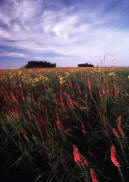 |
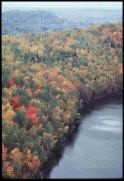 |
 |
|
Minnesota’s natural lands
are a defining component of the state’s quality of life.
|
Fragmenting natural lands
contributes to habitat loss, degrades water quality, and reduces
commercial and recreational uses of natural resources.
|
|
|
How will this goal be accomplished?
DNR will continue to acquire and manage public lands that provide
recreation and other natural resource opportunities. DNR will continue to
cooperate in efforts to maintain, restore, and connect natural lands and
waters, working with partners across ownerships and landscapes.
The agency will also continue to use grants, education, and technical
assistance to help local governments, communities, and private landowners
identify, protect, and manage natural lands and agricultural lands, which
traditionally provide large tracts of land for hunting, wildlife
observation, and other outdoor recreation activities. Communities,
particularly in the fast-growing counties ringing the Twin Cities metro area
and in the growth corridor between the Brainerd Lakes area and Rochester,
have a narrow window of opportunity to acquire and protect open space and
natural areas before they disappear.
|
|
What is DNR’s progress to date?
Wildlife Management Areas. DNR manages more than 1,380 public
Wildlife Management Areas (WMAs) covering 1.2 million acres in 86 of the
state’s 87 counties. These areas provide recreation for hundreds of
thousands of hunters and wildlife watchers each year. Annual targets for WMA
protection are based on stakeholder input and long-range plans.
|
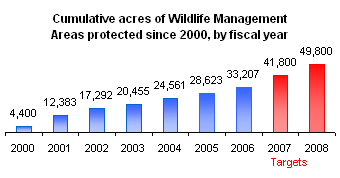
|
|
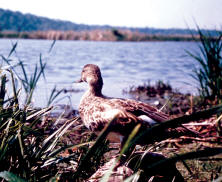 |
|
Minnesota has more than 1,380 public wildlife areas covering 1.2 million
acres of habitat. DNR plans to add 8,000 acres to the WMA system each year
during FY07–FY08. Stakeholders recommended in December 2002 that DNR acquire
21,000 acres for the WMA system per year for 10 years, then 12,250 acres per
year for 40 years. |
|
|
|
Farmland conservation. The landscape in Minnesota’s agricultural
areas has been dramatically altered by farming. Wildlife populations
declined as the historic prairie wetlands of southern and western Minnesota
were converted to croplands. Federal farm policy has played an important
role in shaping this landscape. The 1985 Federal Farm Bill’s Conservation
Reserve Program (CRP) has provided substantial conservation opportunities on
agricultural lands.
DNR has increased collaboration with the Minnesota Board of Water and Soil
Resources
(BWSR), Pheasants Forever, and local Soil and Water Conservation
Districts (SWCDs) to promote the conservation provisions of the 2002 Federal
Farm Bill on private lands. In FY05, 06, & 07 DNR provided $337,500 to hire technicians, who
worked out of local SWCD county offices, to help landowners enroll in
Federal Farm Bill conservation programs. DNR is encouraging enrollment in
continuous CRP and the state’s Reinvest in Minnesota (RIM) program.
|
|
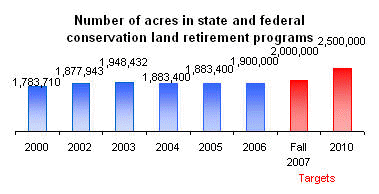 |
|
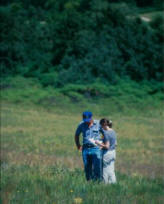
|
Nearly 2
million acres of land have been enrolled in conservation programs to improve
soil and water quality and increase wildlife habitat. Natural resource staff
help tailor conservation programs to individual farming operations.
|
|
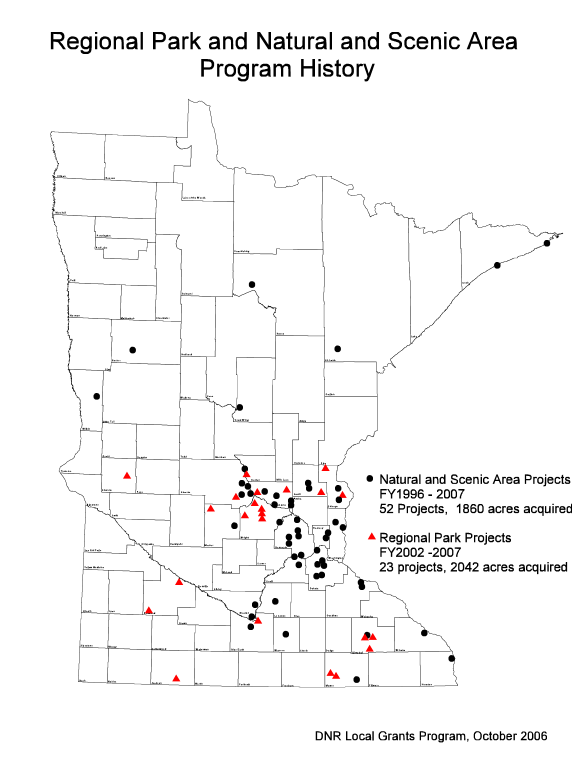
Click on the map for a larger version. |
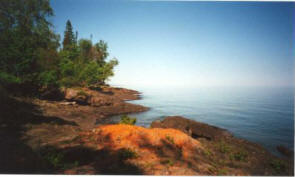
Lutsen Township, Natural and Scenic Area |
| DNR has awarded
matching grants to local communities for acquisition and development
of 75 regional parks and natural and scenic areas totaling 3,902
acres since 1996. |
|
|
|
|
Community land protection projects. Open spaces are often lost
because local governments lack resources to acquire them. DNR matching grant
programs help by reimbursing local governments for 50 to 60 percent of the
appraised value. Because local governments assume responsibility for the
areas, this partnership allows the state to help protect natural resource
and recreation areas without having to operate or maintain them. In the last
six years, DNR helped local governments acquire 2,042 acres of regional
parkland outside the Twin Cities metro area. Over the last ten years, 52
Natural and Scenic Area grants helped local governments acquire almost 1,860
acres of high-quality land. |
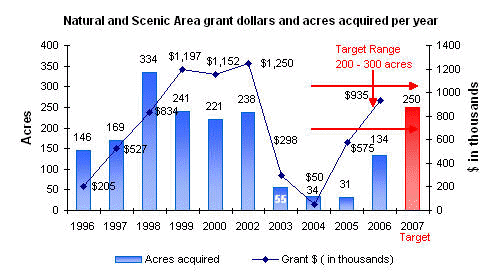 |
Natural and Scenic Areas
Grants. Grants totaling more than $7.6 million have helped local
communities acquire 1,811 acres of high-quality land. The DNR has
established a target of approximately 200 to 300 acres per year in 2007-08 and
thereafter. |
|
|
Greater Twin Cities metro area habitat. DNR will continue to collect and analyze data
and provide technical assistance to communities to increase awareness of
ways to conserve natural resources. In the Twin Cities metro
area, for example, DNR developed an ecological assessment that identified approximately
280,000 acres of undeveloped high-quality terrestrial and wetland habitats.
This information helps communities direct conservation actions. Two key
partnerships that support the protection and restoration of targeted habitat
acres in the 14-county greater metro area are DNR's Metro Greenways Program
and the Metro Conservation Corridors Partnership, a consortium of non-profits and local governments. During FY2004 -2005 these programs protected
1,716 acres and restored 1,778 acres. During FY2006 - 2008, these programs
aim to protect an additional 2,600 acres and restore 2,000 more habitat
acres. |
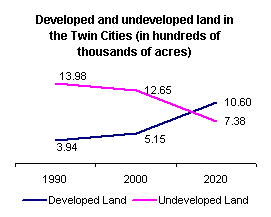 |
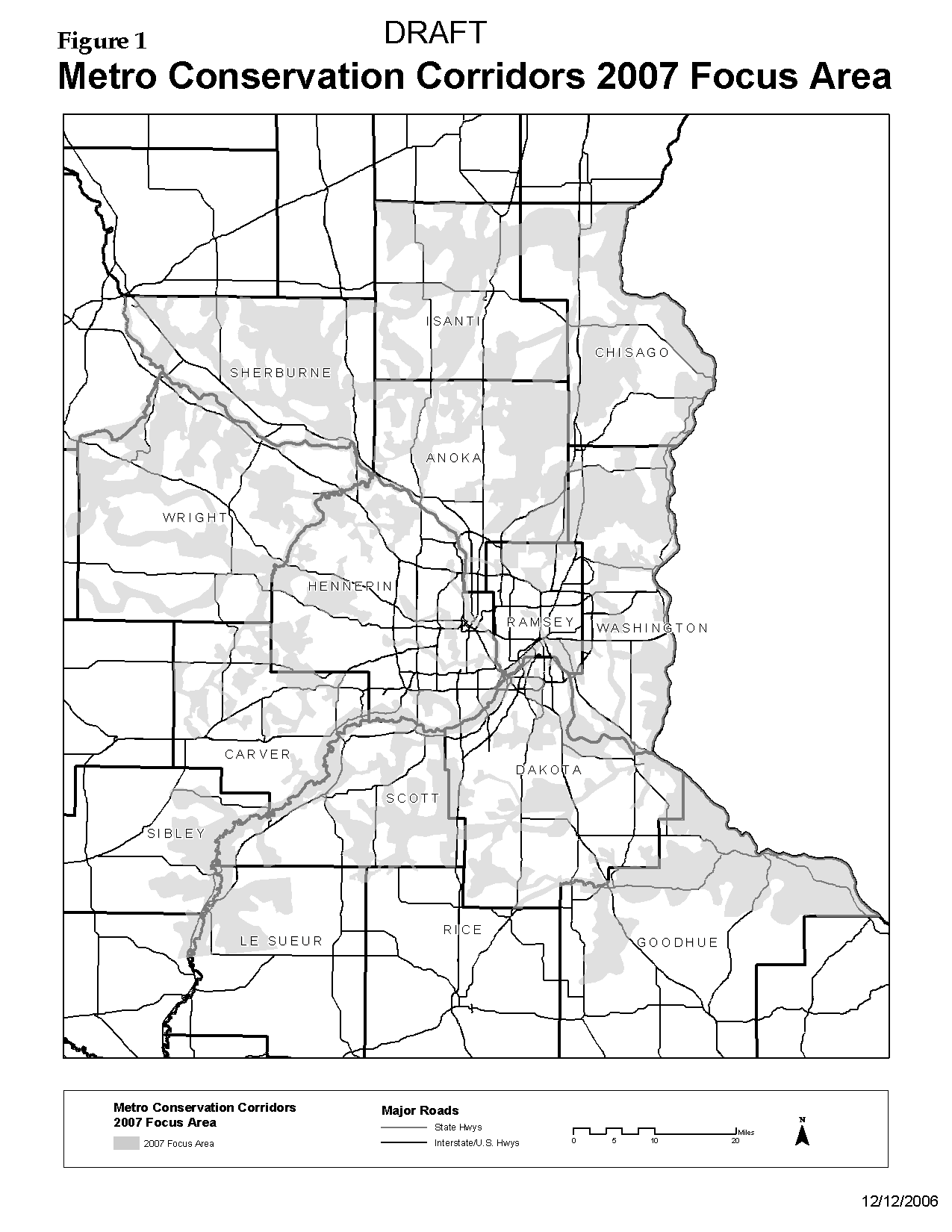 |
|
As developed land increases in
the Twin Cites, opportunities to conserve natural lands decreases.
Data is based on Metropolitan
Council’s Land Use layers from 1990, 2000, and Regional Planned Land
Use, which is a compilation of comprehensive plans from townships
and municipalities. |
Natural habitats contribute to
Minnesota's high quality of life and economic stability. The Metro
Conservation Corridors Partnership and Metro Greenways directs
habitat protection and restoration toward interconnected areas of
regional ecological importance. |
|
|
|
|
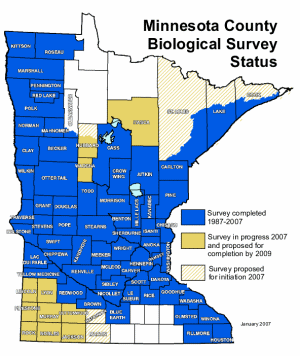 County Biological
Survey. Most Minnesota land is not directly managed by DNR. Thus, an
important goal for DNR is to ensure that all landowners have the information
they need to manage natural resources. The Minnesota County Biological
Survey (MCBS) helps meet that goal by providing baseline information about
unique natural areas and rare features, and tools to help sustain them. County Biological
Survey. Most Minnesota land is not directly managed by DNR. Thus, an
important goal for DNR is to ensure that all landowners have the information
they need to manage natural resources. The Minnesota County Biological
Survey (MCBS) helps meet that goal by providing baseline information about
unique natural areas and rare features, and tools to help sustain them.
The MCBS is a systematic survey of the state's native plant communities,
rare species locations, and potential natural areas. Survey information is
made available in various formats, including maps, publications, and
electronic data files. Surveys are completed in 61 of Minnesota’s 87
counties, underway in fourteen others, and being proposed for two additional
counties.
The DNR has established a target of completing surveys for 70 counties by
2008
and all counties by 2021.
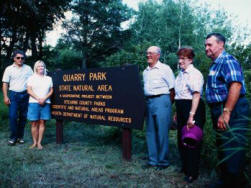 |
Using County Biological Survey information and
a Natural and Scenic Area grant, Stearns County expanded its Quarry
Park Natural Area, now a 622-acre multi-use area providing habitat
for rare populations of a rein-orchid, Red-shouldered Hawk, and
Acadian Flycatcher. |
|
|
|
|
Learn more about:
 Wildlife
Management Areas
Wildlife
Management Areas
 Conserving
natural lands in urban and developing areas
Conserving
natural lands in urban and developing areas
 Local
communities use information on natural features and rare species
Local
communities use information on natural features and rare species |
| |
|
Goal:
Minnesota’s fish and wildlife will be conserved and enhanced |
|
Why is this goal important?
Minnesota’s rich natural heritage is integral to its citizens’ high quality
of life. The state ranks second in the nation in the percentage of its
population that engages in fishing and wildlife viewing. Fifteen percent of
Minnesotans hunt or trap—the sixth-highest percentage in the United States.
In 2001, anglers spent $1.3 billion in Minnesota. Expenditures by people
participating in bird-watching, wildlife tourism, bird feeding, and wildlife
photography in Minnesota grew from $383.2 million in 1996 to $523.5 million
in 2001—an increase of 36.6 percent in five years.
|
|
How will this goal be accomplished?
DNR conserves and enhances fish and wildlife by managing and restoring fish,
wildlife, and native plant populations and their supporting habitats.
Specific activities include monitoring, research, habitat protection through
acquisition and management, restoration and recovery of common and
endangered species, and education.
DNR has stewardship responsibility for:
• more than 50 big game, small game, waterfowl, migratory bird, and
furbearer species managed through regulated harvest
• 311 bird species, 84 species of mammals, 53 species of amphibians
and
reptiles, and 49 species of mussels
• 439 species that are endangered, threatened, or of special concern
• 5,400 fishing lakes, 15,000 miles of streams, 3,600 miles of trout
streams, 1,575 public water access sites, and 309 fishing piers and shore
fishing sites
|
|
What is DNR’s progress to date?
Native shoreland habitat
restoration and protection. DNR provides education, technical assistance,
and grants to private citizens, conservation organizations, and local
governments to restore altered shoreland habitat in order to expand
diversity and abundance of native aquatic plants, improve and protect
quality of shoreland habitat, and enhance and protect water quality. Since
1998, over 206 sites comprising 74,928 linear feet and over 54 acres of
shoreland habitat have been restored by DNR’s Shoreland Habitat Program.
DNR produces educational materials on conserving and restoring shoreland
habitat, including the book Lakescaping for Wildlife and Water Quality
and the interactive CD-ROM Restore your Shore: A guide to protecting and
restoring the natural beauty of your shoreland. It also hosts shoreland
management workshops for citizens, natural resource professionals, and
nursery and landscaping companies.
|
|
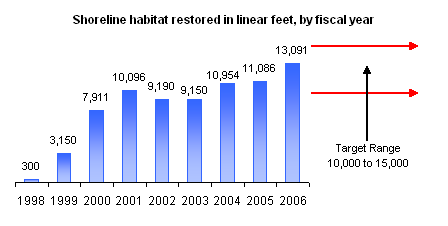 |
Shoreline habitat restoration. DNR has
helped restore 74,928 linear feet of lakeshore since its Shoreland
Habitat Program began. The DNR hopes to restore 10,000 to 15,000
linear feet of shoreline each year.
|
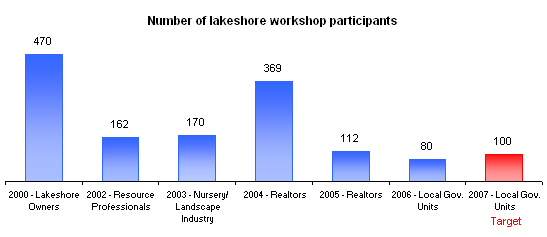 |
DNR shoreline management workshops
target different audiences each
year and have reached more than 1,400 individuals since 2000. The
DNR aims to reach 100 local government officials in 2007.
|
|
|
Fishing Opportunities: Overall, Minnesota’s important game fish are in
good condition including largemouth and smallmouth bass, muskellunge, brook
and brown trout, and Lake Superior lake trout populations. Walleye numbers
in lakes with natural reproduction are generally good to excellent. Walleye
stocking has undergone an extensive lake-by-lake review. Current stocking
guidelines are based on an analysis of the success of different stocking
rates. Bluegill, black crappie, northern pike, and yellow perch
numbers remain high, but decreasing average size is a major concern.
Challenges to sustain healthy fisheries include rapid land use change,
habitat degradation, fish diseases, invasive species, and new recreational
demands. Healthy aquatic ecosystems and sustainable fisheries require a
stewardship ethic among all Minnesotans.
Walleye stocking and population levels. DNR stocks walleye fry and
fingerlings into approximately 900 lakes where natural reproduction is
inadequate to provide a fishery. Walleye populations have increased in
stocked lakes since 1977. The DNR has established a target of 160,000 pounds
of fingerlings stocked per year. This target, set with stakeholder input,
helps keep the state’s stocked walleye fishery in good shape. Annual
variations above or below the target are to be expected because walleye
fingerling production is strongly influenced by weather.
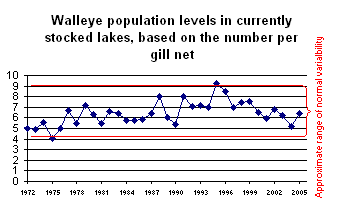 |
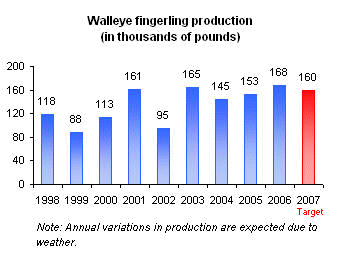 |
|
Walleye in currently stocked lakes.
Walleye abundance in stocked lakes remains good and continues to
fall within the normal range of variability. |
Walleye stocking.
DNR’s
target is to stock 160,000 pounds of walleye fingerlings per year. |
|
| |
|
Wildlife Population Status: Overall, populations of many wildlife species,
including wild turkeys, bald eagles, black bears, and Canada geese, are at
or near all-time highs. Minnesota has the best ruffed grouse populations in
the country, is a major waterfowl production state, and has successful
trumpeter swan and peregrine falcon restoration programs. DNR devotes
considerable effort to addressing the needs of rare or declining species and
to dealing with damage and nuisance issues associated with abundant
populations of wildlife such as deer, bears, and geese. Conservation of
wildlife populations is increasingly challenged by widespread land-use
change and habitat disruption.
Loon populations. Minnesota is summer home to approximately 12,000
adult loons—the largest population in the continental United States. Loons
reflect the overall quality of Minnesota’s lakes. To assess the stability of
loon populations over time, DNR's Minnesota Loon Monitoring Program relies
on nearly 1,000 volunteers using standardized protocols to collect data on
six 100-lake "index areas" in central and northern Minnesota. Loon
populations are currently stable in all six index areas, but it
will be a challenge to maintain stable loon populations in the face of
development and loss of healthy shoreline habitat. The Aitkin/Crow Wing
index area is of interest because the lakes are on predominantly private
lands in a region of rapid population growth.
|
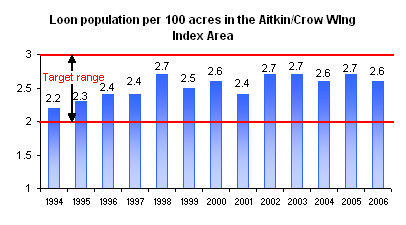 |
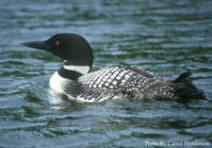
|
|
Loon
populations.
The conservation target for viable loon populations is 2 to 3 adults
per 100 acres of lake in the Aitkin/Crow Wing area.
Because of
natural variability, loon populations will fluctuate somewhat from
year to year.
|
|
Hunter satisfaction levels.
DNR is committed to providing high-quality recreational experiences
associated with wildlife. Hunter satisfaction is related to healthy
wildlife populations and habitats, but is also affected by the
degree of crowding, availability of hunting areas, animals seen,
animals bagged, size of animals, length and timing of seasons, bag
limits, and other factors.
The target is to maintain 90 percent satisfaction rates among
hunters. While general surveys indicate overall hunter satisfaction
at or near this target for hunting in general and for deer hunting,
specific types of hunting such as waterfowl fall below this target.
|
|
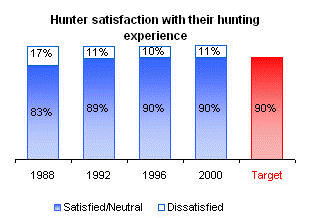 |
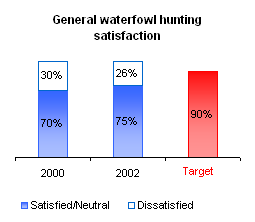 |
|
Hunter satisfaction. Over the years, close to 90 percent of all
hunters have been satisfied with or neutral about their hunting
experience. |
Waterfowl
hunter satisfaction. DNR seeks to improve satisfaction among
waterfowl hunters. |
|
| |
|
Wild turkey hunters and harvest. In 1978 the
first spring turkey season was held with 10,720 people applying for 420
available permits. Since then, wild turkeys have greatly increased their
numbers and range. For spring 2007, DNR offered 33,976 permits in 66
different permit areas and received more than 48,000 applications. Continued
growth in wild turkey populations and well-managed hunting seasons are
necessary to maintain or improve hunter satisfaction. |
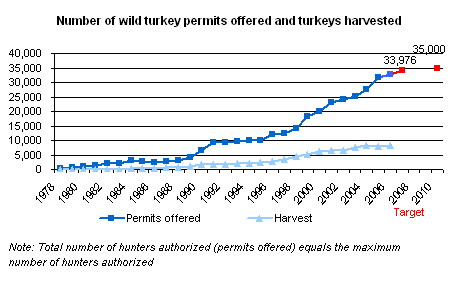 |
Wild turkey hunting opportunities. As
wild turkeys increase their numbers and range, so do hunting
opportunities. DNR sets permits to ensure healthy turkey populations
and quality hunting experiences. The DNR offered 33,976 permits
in 2007 and hopes to offer 35,000 permits by 2010. |
|
|
Waterfowl habitat and harvest. About
120,000 waterfowl hunters and another 437,000 waterfowl watchers generate expenditures of nearly $225 million in
Minnesota each year. In recent years Minnesota’s share
of the Mississippi Flyway duck harvest has declined to unsatisfactory
levels.
The DNR aims to increase two types of waterfowl habitat, wild rice lakes and
prairie wetland complexes, through active management. Wild rice lakes occur
primarily in the forested regions of the state. DNR and partners, such as
Ducks Unlimited, will increase the number of actively managed wild rice
lakes to at least 170 in the next 10 years. Prairie wetland complexes, found
in the historical prairie areas of Minnesota, are valuable waterfowl habitat
when they cover at least 4 square miles and include a variety of wetland and
grassland types. DNR and partners have joined together in the Working Lands
Initiative to increase the number of high-quality complexes through state,
federal, and private conservation efforts. In addition, the draft Minnesota
Duck Plan defines specific strategies to recover breeding and migrating duck
populations. |
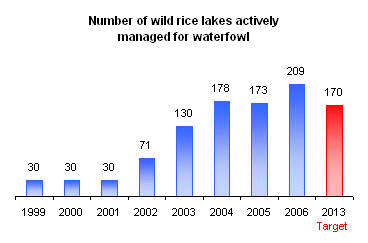 |
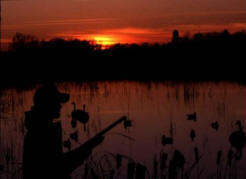
|
Number of actively managed wild rice lakes.
The DNR and other partners, such as Ducks Unlimited, actively manage
wild rice lakes to increase ideal waterfowl habitat. |
DNR’s target is to
increase two ideal kinds of waterfowl habitat—prairie wetland
complexes in the historical prairie areas of Minnesota, and wild
rice lakes in the primarily forested regions of the state.
|
|
|
|
|
Hunter recruitment. Hunting is an important
part of Minnesota's outdoor heritage and culture. Yet there are changes
in participation in this traditional activity. Between 2000 and 2005 the
percentage of Minnesotans between the ages of 16 and 44 who hunt
decreased by 14%. DNR has initiated efforts to promote and sustain
hunting by identifying barriers to participation and enacting programs
and policies that reduce or remove them. The department has reduced
youth hunting license fees, eliminated age restrictions for turkey
hunters, initiated special youth hunts, and is working with
hunting organizations to provide mentoring experiences. DNR is also
developing marketing strategies to boost youth hunter participation.
Under new authorization granted by 2007 legislation, DNR is initiating
an apprentice hunter program.
DNR's target is to maintain youth hunter
participation as measured by license sales and increase special youth
hunt opportunities in 2007. This target represents a systematic strategy
to sustain hunter participation rates.
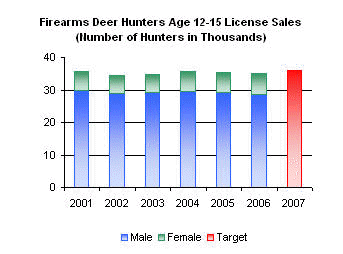 |
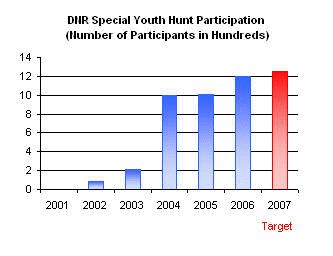
|
Number of youth license sales..
DNR's target is to maintain youth hunter participation. |
Number of participants in special youth hunts.
DNR's target is to increase special youth hunt opportunities in
2007. |
Learn more about:
 Fish
management
Fish
management
 Common loon
Common loon
 Minnesota
hunting
Minnesota
hunting |
| |
|
Goal:
Minnesota’s water resources and watersheds
will be conserved and enhanced |
|
Why is this goal
important?
Minnesota’s lakes, rivers, streams, wetlands, and groundwater are defining
components of the state’s ecosystems and major resources for tourism,
recreation, drinking water and municipal uses, and economic development.
Water resources are threatened by growing demand and degradation.
Pressing issues include non-point source pollution, loss of wetlands,
shoreland development, invasive species, and groundwater quantity and quality.
Particularly challenging are cumulative impacts. Small, individually
insignificant land-use changes may seriously degrade water resources when
taken as a whole. For example, the impact of one lakeshore owner removing
shoreland vegetation may be minor. But if all lakeshore owners do the same, shoreland habitat disappears, fish and wildlife diminish, and lake quality
declines. Solutions require collective action through partnerships among
citizens, community groups, local governments, and state and federal
agencies.
|
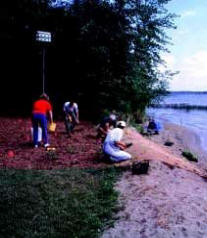
DNR partners with citizens and local groups to
restore shoreline habitat and promote water quality. |
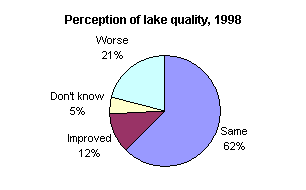
Perceptions of lake quality. About one in five Minnesota
lake users responding to a 1998 statewide survey perceived the lake
they used most to be in a state of decline. About three in five
thought it was remaining the same, and about one in 10 thought it
was improving.
|
|
| |
|
How will this goal
be accomplished?
DNR’s greatest water management challenges are wise allocation in the face
of increasing demand, and protection from damage. In the past DNR treated
water issues as isolated problems and managed wetlands, surface water, and
groundwater as separate resources. Today the agency views these as
interdependent systems that can be degraded by cumulative effects, leading
to diminished water quality, loss of fish and wildlife, and water use
conflicts.
DNR works with other state agencies and local governments to administer the
state’s water laws and help communities manage water resources. Other state
agencies playing key roles in water management include the Minnesota Board
of Water and Soil Resources, the Minnesota Pollution Control Agency, the
Minnesota Department of Agriculture, and the Minnesota Department of Heath.
For instance, as part of the Clean Water Legacy Initiative, DNR is
increasing its focus on identifying impaired waters, helping local
communities develop plans to address impairments, and providing assistance
in the implementation of restoration plans.
Progress toward healthy water resources is hard to measure because of the
interrelated nature of the water bodies, the water/land connection, and the
multiple jurisdictions involved. The following indicators define a few of
DNR’s activities related to water supply, flood damage reduction, surface
water protection, and invasive species.
|
|
What is
DNR’s progress to date?
Water Supplies. The Governor’s Clean Water Vision calls for monitoring
watersheds and providing adequate and sustainable supplies of clean water.
In cooperation with citizen volunteers and numerous local governments,
DNR measures precipitation at over 1,400 sites across the state, water
levels in over 900 lakes, streamflow at over 100 gaging stations, and
groundwater levels in over 750 observation wells. Clean Water Legacy funding
(FY2007) increased DNR's capacity to measure stream flow. DNR also works with the Minnesota Geologic
Survey to conduct hydrogeologic assessments across the state. Monitoring
information helps ensure adequate and sustainable supplies of clean water.
Local governments use it to plan and manage land and water resources.
Growth in demand on water resources is outstripping population growth.
Without planning, shortages may occur. Surface waters (wetlands, lakes,
rivers and unique resources such as trout streams and fens) can be degraded
by groundwater pumping or land-use changes. DNR helps communities find
reliable sources of water and manage water and land use to sustain
high-quality water resources.
|
|
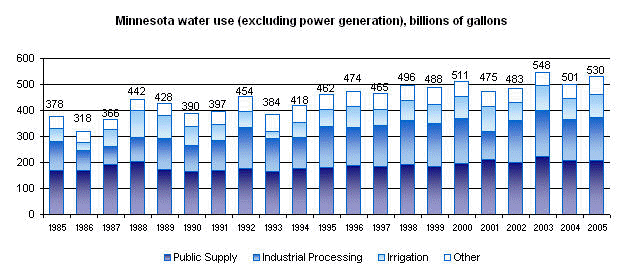
|
|
Hydrogeologic information. The County Geologic
Atlas and Regional Hydrogeologic Assessments provide hydrogeologic
information to help communities manage water resources. Fifteen atlases and
five assessments have been completed, covering areas that include 78 percent
of the state’s population and 39 percent of the state’s area. The target is
to produce one additional atlas in 2007. |
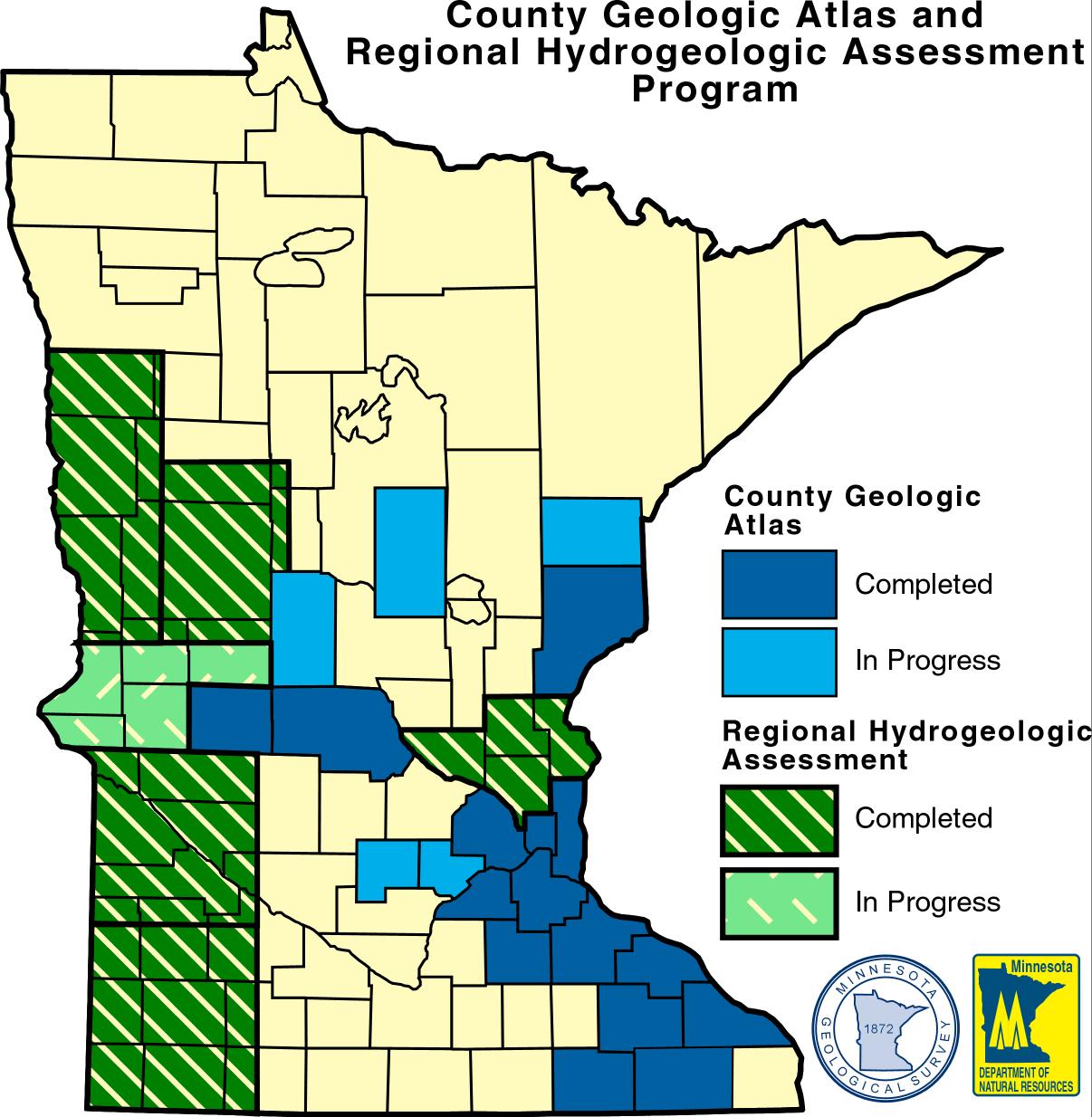
Communities use hydrogeologic information to
manage land and water resources. Data and maps for some areas are
available via the DNR Web site. |
|
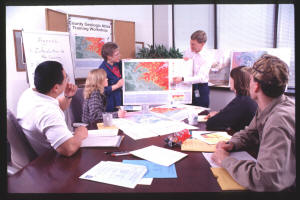
DNR trains county staff to use
County Geologic Atlas data and maps. This
information helps guide local water planning efforts. |
|
| |
Well sealing. Unused wells should be sealed so
they don’t carry contamination to groundwater or pose a falling risk to
people and animals. Until all unused wells on state-administered lands are
sealed, the state will not be in compliance with the law and may be liable
for costs of cleaning up contamination entering these wells. Minnesota law
requires DNR to inventory wells on state-administered lands and prepare a
plan and appropriation request to seal inactive wells. Through June 30,
2006, DNR has searched for wells on 2,107 sites and sealed 1,039 unused wells.
The program has completed its work in 83 counties.
|
| By FY2008, DNR expects that the program work will be
mostly complete. All site
searches have been completed. Thirty-five wells remain to be sealed in
areas that are difficult to access due to, for example, wet soils. DNR plans
to
seal these wells by June 29, 2007. |
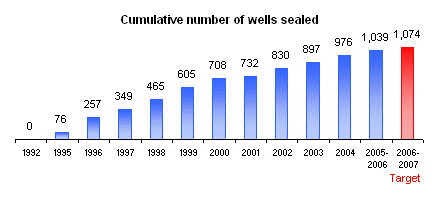 |
Number of wells sealed on state lands.
Over the past 14 years, DNR has sealed an estimated 97 percent of
inactive wells on state land. The well-sealing program will nearly
complete its work in FY 2007. |
|
|
Flood Damage Reduction. Flooding is a natural
part of river systems, but extreme floods can harm people and property.
While some causes of flooding—climate and precipitation—are beyond our
control, we can reduce flood damage by protecting healthy watersheds and
preparing for floods when they do occur. DNR monitors 38 stream gauges
around the state to provide data for flood forecasting and promotes sound
land use in flood plains. The agency helps local governments plan, carry
out, and pay for flood damage reduction measures.
Since 1987, DNR has provided funds to communities to build
flood-control structures, define flood hazard areas, and buy and remove
flood-prone buildings. Austin, for example, spent some $13 million to
acquire flood-prone homes and businesses. When major flooding occurred there in 2000
and 2004, cost
savings due to removal of flood-prone buildings approached the cost of
acquiring the structures.
DNR also supports local flood-plain management zoning and regional
flood-control efforts, such as those in the Red River Valley. DNR will work
with the Governor’s Initiative in the Red River Valley to develop indicators
and targets related to minimize flood damage. DNR's objective is to maintain
or increase efforts to remove buildings from flood plains with available funding
and through other cooperative efforts.
|
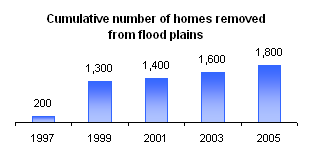 |
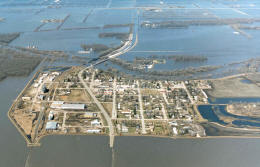 |
|
Number of buildings removed from
flood plains. By removing homes and businesses from flood plains, DNR and
communities saves the expense and danger of protecting them when
floods occur. |
Oslo, Minnesota, during the devastating Red
River flood of 1997. This event spurred efforts for greater
coordination of flood protection throughout the Red River valley. |
|
| |
|
Surface Waters. Surface waters—lakes, rivers
and streams, and wetlands—face many pressures. Shorelands are being
developed. Nearly 30 percent of Minnesota streams have been channelized.
Wetland quantity and quality face uncertain futures. About two-thirds of the
state’s lakeshore is privately owned; so private landowners are key to
conservation. DNR educates citizens and local governments on water issues
and helps them carry out water protection programs. As part of the
Governor’s Clean Water Vision, DNR is providing technical assistance
to any county or municipality that is interested in updating its shoreland
zoning standards to include some or all of the new alternative standards
that the DNR developed in consultation with a diverse group of stakeholders.
|
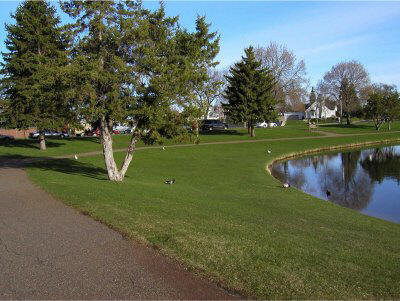 |
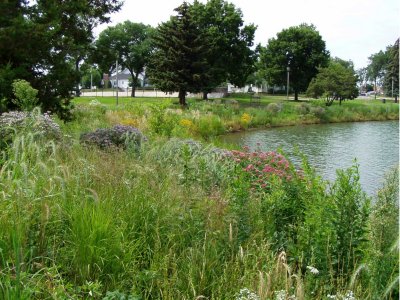 |
Before and after lakescaping. Private land
management can enhance the quality of surface waters and habitat |
|
|
|
|
Volunteer stewardship. DNR supports volunteer
efforts to improve Minnesota’s surface waters, including river and shoreline
restoration projects. One such program, the Adopt-a-River program,
encourages volunteers to carry out annual cleanups on a section of a lake,
river, wetland, or ravine. Between 1989 and 2006, over 67,000 volunteers
completed nearly 2,300 cleanups. They removed over 4.8 million pounds of
rubbish from public waters and in 2005 alone, 139 cleanup efforts removed
over 149,000 pounds of trash. |
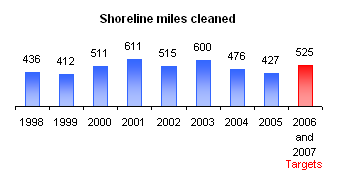 |
DNR’s Adopt-A-River Program aims
to spearhead volunteer cleanups of 525 miles of shoreline each year
in FY 2006 and 2007. |
|
|
Harmful invasive species
prevention. Eurasian watermilfoil
and zebra mussels are invasive species that harm Minnesota waterways. Eurasian watermilfoil has displaced native plants, degraded habitat for fish and
wildlife, and limited lake recreation. Zebra mussels can block industrial
water intakes, thereby increasing operating costs, and eliminate populations of
native mussels. Unintentional transport on trailered watercraft is believed
to be the primary means of spread for such harmful invasives.
DNR stations some 40 seasonal watercraft inspectors each year at public
water accesses, primarily on infested water bodies, where they inspect boats
and inform boaters about harmful invasives and actions they can take to prevent spread.
Numbers of water bodies with Eurasian watermilfoil and zebra mussels likely
are much lower than they would have been without these efforts.
DNR’s Invasive Species Program surveys Minnesota boaters and monitors the
distribution of invasives to evaluate containment efforts. The best way to
manage a harmful invasive is to prevent its establishment. DNR is working to
prevent new introductions such as the Asian carp.
The DNR aims to maintain high levels of awareness among boaters, limit the
rate of spread of Eurasian watermilfoil to 10 water bodies per year, and prevent
spread of zebra mussels to waters not connected to previous infestations. |
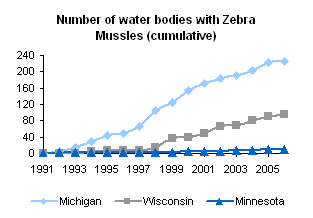 |
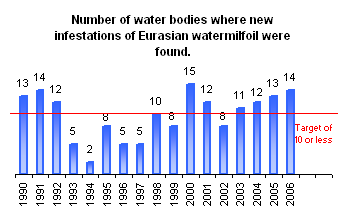 |
|
Minnesota populations of zebra mussels are relatively low—and DNR
aims to keep them that way. |
DNR control
efforts have helped keep Eurasian watermilfoil from spreading
exponentially through Minnesota’s waterways. |
|
|
Learn more about:
 Water resources
and programs
Water resources
and programs
 Rivers, streams
and wetlands
Rivers, streams
and wetlands
 Invasive species
Invasive species
|
| |
|
Goal:
Minnesota’s forests will
be managed for a full range of forest values |
|
Why is this goal
important?
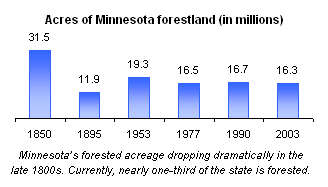 Forests
are integral to Minnesota’s environmental and economic health. They provide
clean water, watershed protection, wood products, fish and wildlife habitat,
biodiversity, recreational opportunities, and more. The value of forest
products made in Minnesota is more than $6 billion per year, up from $4 billion
in the mid-1980s. Minnesota is challenged to protect forestlands from
conversion, maintain healthy forest ecosystems, and enhance forest-based
economic and recreational benefits. Forests
are integral to Minnesota’s environmental and economic health. They provide
clean water, watershed protection, wood products, fish and wildlife habitat,
biodiversity, recreational opportunities, and more. The value of forest
products made in Minnesota is more than $6 billion per year, up from $4 billion
in the mid-1980s. Minnesota is challenged to protect forestlands from
conversion, maintain healthy forest ecosystems, and enhance forest-based
economic and recreational benefits.
|
|
Minnesota’s growing population has intensified
pressures on forestlands:
• Urban and lakeshore development is the major cause of forestland loss.
• Large blocks of industrial forestlands are being sold to timber investment
management organizations, which increases the likelihood of subdivision,
sale, and development.
• Development increases wildfire risk, reduces forestland quality and public
access, and makes forestlands harder to manage.
• Recreational use of forestlands and recreational facilities has increased.
• Timber harvesting demand has increased.
In the next 10 years, DNR anticipates forestland will continue to develop,
leaving fewer large blocks for timber production, wildlife habitat, and
recreation. Sustaining forest resources will become more complex as society
simultaneously seeks more benefits from and applies more pressure to
forests.
|
|
How will this goal
be accomplished?
Forest sustainability requires striking a balance between conserving
forest ecosystems for future generations and providing for current use. DNR
works to conserve forests while ensuring the availability of sustainable
forest-based economic and recreational opportunities.
|
|
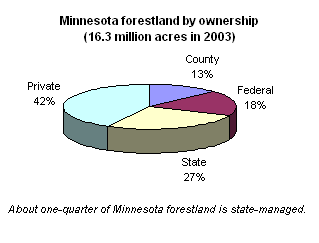 DNR
manages 4.5 million acres of forestland—about 27 percent of the state’s
total—for multiple values. It also protects people, property, and natural
resources from wildfires; helps landowners and communities restore and
improve forests; produces tree seedlings, and develops and implements
sustainable forestry policies as part of the Sustainable Forest Resources
Act. DNR
manages 4.5 million acres of forestland—about 27 percent of the state’s
total—for multiple values. It also protects people, property, and natural
resources from wildfires; helps landowners and communities restore and
improve forests; produces tree seedlings, and develops and implements
sustainable forestry policies as part of the Sustainable Forest Resources
Act.
The following indicators and targets highlight DNR’s work in forest
certification, timber sales, old-growth forest conservation, and private
forest stewardship.
|
|
What is DNR’s
progress to date?
Forest certification. Third-party audited certification is an increasingly
popular tool for verifying that forestland is sustainably managed. In 1998
DNR and Aitkin County received third-party certification for state- and
county-administered forestlands in Aitkin County, the first public
forestlands to be certified in the United States. Since then, interest in
certification has grown worldwide.
In
response to anticipated market demand and to the Governor’s Task Force
Report on the Competitiveness of Minnesota’s Primary Forest Products
Industry, DNR committed to completing certification of state-administered
forestlands.
In December 2005, DNR sucessfully met its ambitious target and completed the
certification of 4.8 million acres of state-administered forestlands. DNR
achieved certification from both the Forest Stewardship Council (FSC) and the
Sustainable Forestry Initiative (SFI). This additional certification will help DNR improve forest management and ensure
a sustainable supply of forest resource products and services from healthy
forests. It will also improve Minnesota’s forest market competitiveness.
|
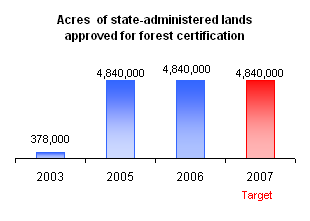 |
 |
|
Forest certification.
DNR met its target of completing certification of all harvestable DNR
forestlands in 2005. DNR's ongoing target is to maintain
certification on 4.8 million acres of state-administered forest
lands. |
To
maintain certification, DNR is required to complete a series of
minor corrective actions over the next two years and undergo annual
audits by FSC and SFI. |
|
| |
|
Timber sales. Sale of timber from state lands
helps fund schools and public services. Harvests also create wildlife
habitat and are used to provide a range of young to mature forest habitat
types. DNR sets harvest targets to ensure a predictable, sustainable supply
of quality wood. DNR’s Subsection Forest Resource Management Planning
process determines the amount of timber offered for sale. Stakeholder input
and legislative mandates help balance timber production with provision of
other amenities such as wildlife, recreation, water quality, and
biodiversity. |
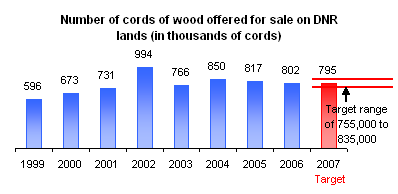 |
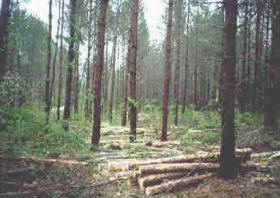 |
|
DNR timber offered for
sale. DNR has met or exceeded its timber-production targets in
most recent years. |
DNR is a major source of wood and fiber for Minnesota’s forest
products industry. |
|
| |
|
DNR has met or exceeded its annual timber-production
targets in most recent years. Targets for FY01–FY03 were higher than those
for previous years due to a legislative initiative offering for sale timber
that, according to management plans, should have been offered in previous
years but wasn’t due to lack of markets and staffing.
DNR's target range is to offer 755,000 - 835,000 cords of timber in FY07 and
780,000 - 860,000 cords in FY08. Offering 755,000 - 835,000 cords of timber
results in timber harvests from DNR lands that generate about $20 million in direct revenue and create 35,000 - 40,000 acres of habitat. Long-term harvest projections will be possible
once DNR Subsection Forest Resource Management Plans are complete.
Current total harvest in Minnesota (all forestlands, all ownerships) is
about 3.6 million cords per year. This is within the range of sustainable
harvest as determined by the 1994 Minnesota Generic Environmental Impact
Statement on Timber Harvesting and Forest Management
(GEIS). That study
concluded that a harvest level of up to 4.9 million cords per year appears
sustainable, “providing recommended mitigation strategies are implemented
within the next few years.” (See old-growth forest indicator below as an
example of a mitigation strategy.)
|
|
Old-growth forests. Old-growth forests
(typically more than 120 years old) provide special habitat for plants and
wildlife, serve as scientific benchmarks, and have aesthetic appeal. Before
European settlement, about half of Minnesota's forests were old growth.
Today less than 4 percent are. In 1994 DNR, forest industry,
and environmental representatives committed to “identify and protect the
highest quality remaining natural old-growth forest communities.” In 2003,
following systematic inventory and evaluation, DNR established an
approximately 40,000-acre network of the highest quality old-growth forest
on state-administered lands. With a recent inventory and designation of old
growth in Itasca State Park, DNR now maintains approximately 44,000 acres of
protected old growth. DNR manages these sites for
old-growth characteristics and they are reserved from timber harvest. |
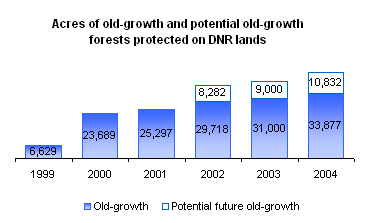 |
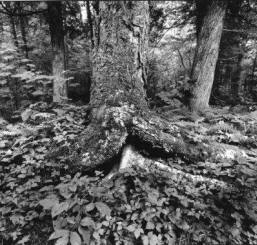 |
|
Old-growth forest acres
on DNR lands. DNR will maintain a 44,000-acre network of old-growth
forest sites. |
This old-growth yellow birch/white cedar forest at Crosby Manitou
State Park provides valuable habitat, scientific information, and
beauty. |
|
| |
|
DNR's objective is to maintain a 44,000-acre network
of designated old-growth forest sites. DNR's old-growth guideline is
adaptive in response to new information. In 2006, 33 acres of old-growth
white and red pine near Burntside Lake were added to the network. As DNR
considers new, high quality stands, some of the lowest quality stands may be
removed from the network. Stakeholders will be consulted if the overall
network changes by 10% relative to the 2006 designated acreage.
|
| |
|
Private forest stewardship. Some 147,000
individuals and organizations (excluding industry) own 40 percent of
Minnesota’s forestland. This land, much of which is in small woodlots, faces
increasing development pressure. The Forest Stewardship Program offers
management expertise and cost sharing for tree planting and other activities
to private landowners who develop plans for sustainable forest management.
Participating landowners pursue sustainable forestry goals, including
improving wildlife, maintaining water quality, and applying sustainable
timber harvesting. |
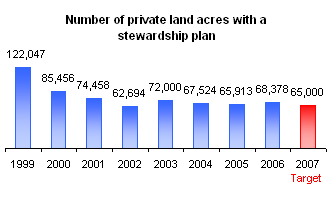 |
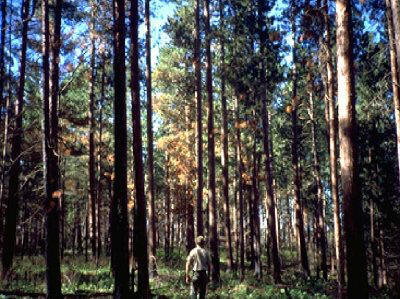 |
|
Forest Stewardship Plans
Completed. More than 1.3 million acres have been enrolled in
forest stewardship plans. |
Stewardship plans promote sustainable management of private
forestlands. |
|
| |
|
More than 1.3 million acres have been enrolled in the
Forest Stewardship Program. Demand from landowners is higher than the
availability of natural resource professionals to prepare plans.
The DNR hopes to have Forest Stewardship Plans completed for 65,000 acres in
FY07 with 18,000 acres completed by DNR staff and the remainder by
the private sector. DNR’s longer-term target is to have 50 percent (2.5
million acres) of non-industrial private forestland (with parcels over 20
acres) under stewardship plans.
|
|
Learn more about:
 Forest
certification
Forest
certification
 Timber
harvesting
Timber
harvesting
 Old-growth
forest
Old-growth
forest
 Forest
stewardship programs
Forest
stewardship programs |
| |
|
Goal:
Minnesota will have a high-quality and diverse outdoor recreation system
|
|
Why
is this goal important?
Outdoor recreation contributes to quality of life and provides personal,
social, economic, and environmental benefits. Scenic touring, fishing, and
visiting state/national parks are among the top five activities for
travelers in Minnesota. Nearly $1.1 billion is spent in Minnesota on trips
for fishing, hunting, or wildlife observation.
Providing outdoor recreation opportunities is a major part of DNR’s mission.
DNR seeks two major outcomes in this area: 1) the public has a satisfying
and safe outdoor recreation experience; and 2) lands and waters remain
healthy. Achieving these outcomes is an increasing challenge as demand for
outdoor recreation grows.
|
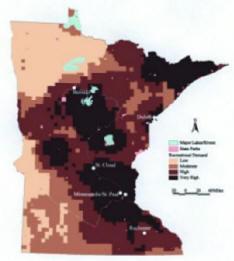 |
Projected Outdoor Recreation
Demand for 2025. As demand grows and diversifies, so must DNR
efforts to provide recreational opportunities while conserving the
quality of Minnesota’s lands and waters.
Click here for a
bigger map. |
|
|
How will this goal be
accomplished?
DNR manages many lands and waters, they
include state parks, recreation areas, trails, scientific and
natural areas, wilderness areas, forests, wild and scenic rivers,
water access sites, wildlife management areas, aquatic management
areas, safe harbors, and more. In all of these areas, DNR works to
provide access to recreation lands and waters, sustain healthy lands
and waters, promote safety, and inform and educate users. For
example, DNR manages parks to maintain high-quality natural and
cultural resources while also promoting their enjoyment. It also
develops trails and water accesses, provides safety classes for
hunting and motorized recreation, and provides information about
outdoor recreation opportunities through the Internet. |

DNR-managed recreational facilities are widely
distributed. There is a state park, for example, within 50 miles of
every Minnesotan. |
What
is DNR’s progress to date?
Minnesota State Parks. Each year some 8 million visitors enjoy
Minnesota’s 73 state parks and recreation areas. Visitors spend $200 million
annually on trips to state parks. Out-of-state visitors to state parks
generate $25 million in income for Minnesota residents. Park visitors
consistently express satisfaction with Minnesota state parks. DNR's goal is
to maintain a 95 percent or higher satisfaction rating. Periodic surveys
will track visitor satisfaction and document which features promote and
detract from satisfaction.
|
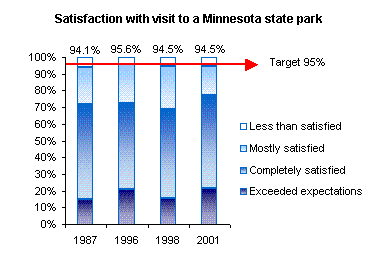 |
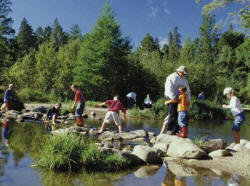 |
|
Satisfaction with visit to a state park.
In recent years 95 percent of visitors have expressed satisfaction
with Minnesota state parks. |
Ten of Minnesota’s top 35 tourism attractions are in state parks. |
|
| |
|
Habitat management. A 2001 survey found that
experiences most important to state parks visitors included enjoying the
sights, smells, and sounds of nature. Each year more than 3 million come to
observe nature and 1.6 million come to watch birds.
Natural resources at a glance:
• State parks provide habitat for 76 species of mammals, 123 species of
fish, 27 species of reptiles, 18 species of amphibians, 320 species of
birds, and thousands of species of insects and plants.
• The state park system contains over 280 endangered, threatened,
or special concern species.
• More than 30 percent of state-managed old-growth forests are in state
parks.
• State parks contain more than 80 types of native plant communities
State parks use many techniques to preserve and restore natural communities,
including preparing soil, collecting seeds, restoring hydrology, planting
native species, and protecting remnants of native vegetation. Restoration
can take decades. Once restored, some plant communities and native habitats
require periodic management, such as prescribed fire, to retain their
quality. DNR's target is to have 5,400 acres in active restoration and carry
out prescribed burns on 3,000 acres each year. |
 |
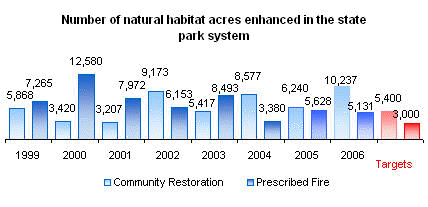 |
|
A prescribed burn helps restore pine forest at Lake Bemidji State
Park. |
State Parks Habitat
Management. The natural habitats in state parks require active
management. Restoration activities are applied periodically to a
range of natural plant communities. Prescribed fire is used to
maintain the health of native prairies and certain forest types.
|
|
Trails and Water Access. DNR administers a
variety of trails and water access sites, including:
|
|
|
|
| |
|
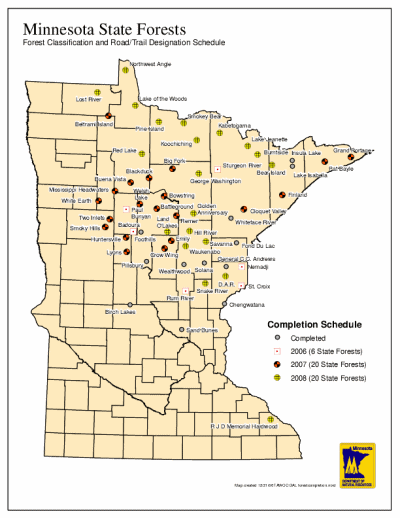 Off-highway
vehicle (OHV) management. OHV use is one of Minnesota’s fastest-growing
outdoor activities. More than 250,000 OHVs now registered in Minnesota
regularly use state forest roads and trails. DNR is
charged with providing opportunities for OHV use while managing and conserving
public lands for the long-term benefit of all Minnesotans. Off-highway
vehicle (OHV) management. OHV use is one of Minnesota’s fastest-growing
outdoor activities. More than 250,000 OHVs now registered in Minnesota
regularly use state forest roads and trails. DNR is
charged with providing opportunities for OHV use while managing and conserving
public lands for the long-term benefit of all Minnesotans.
In 2003, the State Legislature enacted legislation calling for a
'forest-by-forest' review of Minnesota State Forests with regard to motor
vehicle use. Modified in 2005, this legislation directs DNR to reclassify
state forests south of U.S. Highway 2 as either 'limited' or 'closed' to
motor vehicle use. North of U.S. Highway 2, forests are to retain their
current 'managed' status, unless modified as a result of the evaluation
process. Building upon a recently completed inventory of existing access
routes, this process examines both motorized and non-motorized routes, then
recommends designating or decommissioning specific roads and trails for motorized and
non-motorized vehicle use. DNR completed its comprehensive forest road and trail
inventory in 2004. Currently, the evaluation of a number of State Forests is
underway, with 13 forests complete, and many more nearly finished or
about to begin (see map). All 58 state forests must be completed by December 31, 2008.
|
|
Number of boat accesses on Minnesota’s lakes and
rivers. Minnesota has 853,000 licensed boats—the fourth highest number
in the nation. Minnesota ranks first in the nation in boats per capita, one
for every six people. Public boat accesses allow the public to enjoy lakes
and rivers.
DNR acquires and develops accesses that provide recreation opportunities.
Throughout the state, DNR field managers work with realtors, lake associations, angling clubs,
local governments, and others with the intent of purchasing new access
sites. The cost of lakeshore, however, is escalating rapidly and cost and
competition are making it harder to buy land.
DNR's objective is to acquire 6 new access sites in FY07 and 15 new access
sites statewide in FY08-09, with special
emphasis on the Mississippi River and lakes larger than 5,000 acres. |
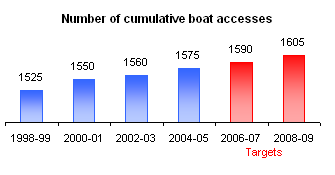 |
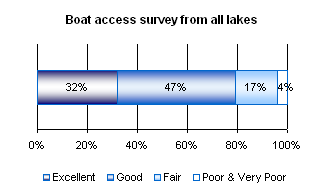 |
| DNR
maintains 1,575 boat accesses on Minnesota’s waters and will develop
6 additional accesses in 2007 and 15 in 2008-09. |
Minnesota boaters
give high marks to public facilities for launching and landing
boats. Data reported here are pooled from surveys of Minnesota's
West Central Lakes Region (2005), Lake Minnetonka (2004),
Mississippi River Pools 4 to 9 (2003), Lake Superior (2002), Central
Lakes Region (2001) and North Central Lakes Region (1998). |
|
| |
|
Learn more at:
 State parks
State parks
 Recreation
motor vehicles and trails
Recreation
motor vehicles and trails
 Public water
access
Public water
access |
|
Last update on
08/30/2007
|
|






























 Forests
are integral to Minnesota’s environmental and economic health. They provide
clean water, watershed protection, wood products, fish and wildlife habitat,
biodiversity, recreational opportunities, and more. The value of forest
products made in Minnesota is more than $6 billion per year, up from $4 billion
in the mid-1980s. Minnesota is challenged to protect forestlands from
conversion, maintain healthy forest ecosystems, and enhance forest-based
economic and recreational benefits.
Forests
are integral to Minnesota’s environmental and economic health. They provide
clean water, watershed protection, wood products, fish and wildlife habitat,
biodiversity, recreational opportunities, and more. The value of forest
products made in Minnesota is more than $6 billion per year, up from $4 billion
in the mid-1980s. Minnesota is challenged to protect forestlands from
conversion, maintain healthy forest ecosystems, and enhance forest-based
economic and recreational benefits. DNR
manages 4.5 million acres of forestland—about 27 percent of the state’s
total—for multiple values. It also protects people, property, and natural
resources from wildfires; helps landowners and communities restore and
improve forests; produces tree seedlings, and develops and implements
sustainable forestry policies as part of the Sustainable Forest Resources
Act.
DNR
manages 4.5 million acres of forestland—about 27 percent of the state’s
total—for multiple values. It also protects people, property, and natural
resources from wildfires; helps landowners and communities restore and
improve forests; produces tree seedlings, and develops and implements
sustainable forestry policies as part of the Sustainable Forest Resources
Act. 













